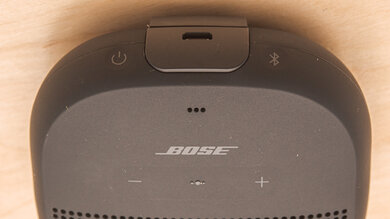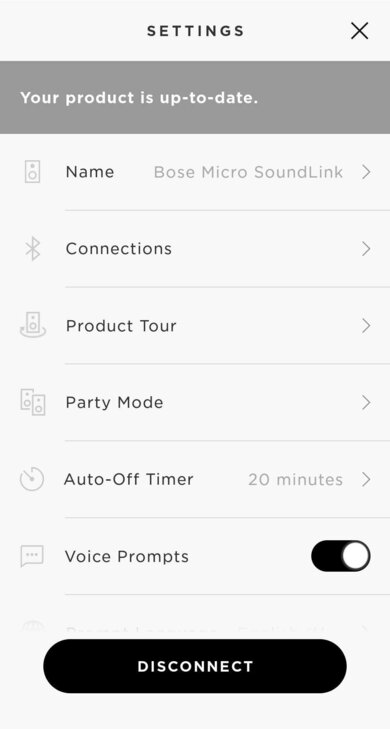The Bose SoundLink Micro is a portable Bluetooth speaker released in 2020. It's one of the manufacturer's more budget-friendly picks, with a small and lightweight design that's ideal for listening to your favorite tunes on the go. The speaker is rated for impact resistance, and its IP67 rating for dust and water resistance means it can withstand light exposure to the elements. Plus, the built-in silicone strap makes it easy to transport, whether you're moving from room to room in your home or out on a hike in the woods.
Our Verdict
The Bose SoundLink Micro is middling for music. It offers a fairly balanced sound out of the box, so voices and lead instruments in your favorite tunes are reproduced with clarity and accuracy. A small dip in the treble adds a slightly dull quality to the mix. Without any customization tools, you can't switch up its sound, either. Also, as with most small speakers, you don't feel the deep rumble in the low-bass with genres like EDM and hip-hop.
- Supports multi-device pairing.
- Doesn't get very loud.
- Lacks low-bass.
The Bose SoundLink Micro isn't meant for movies, but if you pair it to your smartphone to watch some videos, it can get the job done. Dialogue is pretty clear, and the speaker's low latency performance means that you don't have any lip-synching issues. However, it doesn't get very loud, and the lack of rumble in the low-bass means you don't get a very cinematic feel.
- Low iOS and Android audio latency.
- Doesn't get very loud.
- Lacks low-bass.
The Bose SoundLink Micro is satisfactory for podcasts. Dialogue is reproduced clearly, meaning you can follow along with all your shows with ease. Its portable design means you can listen all around your house or even in your backyard. You can even pair it with up to two devices at a time, meaning you can switch your audio source in no time.
- Supports multi-device pairing.
- Doesn't get very loud.
The Bose SoundLink Micro is middling for voice assistant use. It doesn't have any voice assistants built in, so if you want to control it with your voice, you'll need to pair it with a smartphone that supports Siri or Google Assistant. The speaker can hear your commands from far away, but it has some trouble in noisier environments.
- Supports multi-device pairing.
- Doesn't have a voice assistant built-in.
- Doesn't get very loud.
The Bose SoundLink Micro is fair for outdoor use. It's a sturdy speaker with a durable design, and its IP67 rating for dust and water resistance means it's certified to withstand some exposure to the elements. It's portable, making it easy to take with you on your next hike, and its built-in silicone strap lets you attach the device to your bag while out and about. It's not loud, so you'll want to stay close to the device while listening.
- IP67 rating.
- Doesn't get very loud.
Changelog
- Updated Aug 15, 2024: We've added a comparison between this speaker and the JBL Clip 5 in App.
- Updated Aug 21, 2023: Updated the Portability picture for greater clarity and consistency between reviews.
- Updated Jan 19, 2023: Updated the review text for clarity and consistency. No changes in test results.
- Updated Jan 17, 2022: Updated IP rating.
Check Price
Differences Between Sizes And Variants
This speaker comes in three color variants: 'Black', 'Midnight Blue', and 'Bright Orange'. You can see its label here. We expect these color variants to perform similarly to our test unit.
If you come across a different variant, please let us know in the discussions, and we'll update our review.
Popular Speaker Comparisons
The Bose SoundLink Micro is a small, portable wireless speaker with a simple design. Its IP67 rating certifies it to be submersible in water up to one meter deep for up to thirty minutes. It's a decent choice for vocal-centric content like podcasts, but there aren't any sound customization features.
See our recommendations for the best portable speakers, the best Bluetooth speakers, and the best waterproof Bluetooth speakers.
The JBL Clip 5 and the Bose SoundLink Micro are both extremely portable speakers with small footprints. They have different mechanisms to fasten themselves onto bags or bikes, with the JBL sporting a carabiner while the Bose features a strap on the back. Their differences extend beyond this, however, as the JBL has a more balanced sound, which can be tuned via a graphic EQ and presets, and it can get louder, too. That said, the Bose can be a more versatile option as it features a longer continuous battery life and voice assistant capabilities when paired with a compatible Siri or Google Assistant device.
The Bose SoundLink Flex is a better speaker than the Bose SoundLink Micro overall. The Flex has a great build quality and can get louder than the Micro. It also offers a better-balanced sound profile that can produce a deeper bass. That said, the Micro is smaller and lighter, making it more portable. It also has lower Bluetooth latency with iOS and Android devices, though some apps compensate for latency differently, and your experience may differ.
The JBL Flip 4 is a better speaker than the Bose SoundLink Micro overall. The Flip 4 has a better-balanced sound profile out-of-the-box, can play stereo content without downmixing it to mono, and can get louder. That said, the Bose is a bit smaller, making it more portable. It has a bit less compression present at max volume, resulting in cleaner-sounding audio at louder volumes.
The Bose SoundLink Micro is a better speaker than the JBL Go 3. The Bose has a better soundstage and longer battery life. It also supports voice assistants, though its performance is sub-par. However, the JBL has an IP67 rating for dust and water resistance, meaning it's certified to be dust-tight and immersible in up to a meter of water for 30 minutes.
Test Results

The Bose SoundLink Micro is a small, square speaker with a silicone rubber design. It's flat and has a rear strap so you can attach it to your bag or bike while on the go. It also comes in three colors: 'Black', 'Bright Orange', and 'Midnight Blue', so you can find a color that best suits your style.
The Bose SoundLink Micro is well-built. It's mostly made of plastic, and there's a quality silicone rubber around the speaker. Also, there's a silicone strap on the back, meaning you can put it on a bike or backpack. It's rated for dust and impact resistance, and its IP67 rating means that it's certified to be submersible in water at a depth of up to one meter for up to thirty minutes.
There are three buttons on top of the speaker. The '+' and '-' buttons allow you to adjust the volume, while the middle button is a multifunction button. Pressing once plays/pauses songs or accepts/ends calls. If you press and hold it, you can use voice control. Double-pressing skips to the next song while triple-pressing skips to the previous track. There's also a Bluetooth button that, once connected, has a light that stays solid light to show your connection. However, there's no feedback when adjusting for volume, and the buttons aren't very clicky.
The Bose SoundLink Micro has a middling frequency response accuracy. Its balanced mid-range means that vocals and lead instruments reproduce pretty clearly, making it suitable for most music genres as well as more vocal-centric content like podcasts. Due to its veiled treble, higher-pitched audio seems a bit dark and dull, though. Like many small speakers, it also really struggles to reproduce the deep thump and rumble in the low-bass, which isn't ideal for fans of bass-heavy genres like EDM. Unfortunately, there's no EQ available to help you customize its sound.
This speaker has a decent soundstage. While it sounds large and wide, it doesn't have separate speakers for its left and right channels. As a result, it has to downmix stereo content into mono to play it, which doesn't create the most immersive listening experience. If you want a portable speaker that can play stereo content, check out the Sony SRS-XB43.
Note: We tested this speaker flat on a table instead of being strapped onto a backpack or used vertically, which may affect its soundstage.
This speaker gets loud enough to fill a small room with sound, but it isn't suited for larger or more open spaces, like a backyard. Also, at max volume, there are some pumping and compression artifacts present, especially in the bass range.
This speaker has mediocre battery performance. Its battery lasts under eight hours and takes quite a while to recharge. However, battery life can vary according to usage, so your experience may differ. Thankfully, there's a battery conservation feature that turns the speaker off after 20 minutes if there isn't any audio playing and you haven't pushed any buttons. There's a voice prompt that lets you know the battery level each time you turn on the speaker.
It goes into battery protection mode after three days if the speaker's battery is fully drained or unplugged and unused while it has less than 10% battery life left. To reactivate your speaker, you need to connect it to a wall charger or a computer that's on. For a portable speaker with longer battery life, consider the Bose SoundLink Color II.
There aren't any voice assistant features built into the speaker, so you need to use the voice assistant on your paired smartphone. As a result, you can't activate it with your voice. On the upside, it can understand you pretty clearly when you're far away.
Bose Connect is an alright app. You can use it on iOS and Android and pair two speakers together to create a stereo pair. You can also link more than one speaker to play the same audio content throughout a large space. Unfortunately, there's no EQ, so you can't tweak its sound profile like the JBL Clip 5.
You can't use the speaker wired. It comes with a micro-USB port for charging only.
This speaker has great Bluetooth performance. It can connect to up to two devices at a time and has an excellent range, so you don't need to be right beside your speaker to use it. It has low audio latency on iOS and Android, making it suitable for watching videos. However, some apps and devices compensate for latency differently, and your experience may vary.






